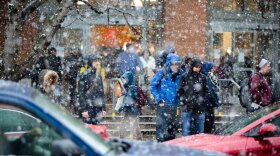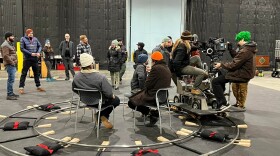In 1886, an angry mob led by a Seattle labor union forcibly removed hundreds of Chinese immigrants from the city. The Wing Luke Museum wants to pay tribute to those affected by the violence by installing a 14-foot-tall statue near Seattle’s waterfront.
The museum selected a design from Seattle artist Stewart Wong to fulfill this mission. His statue is an X-like structure with three people on either side of it, meant to represent a divide between the workers and the Chinese immigrants. Other symbols include rifles and imbalanced scales of justice.
Wong hopes the statue sparks conversation and brings awareness to the incident.
"The biggest challenge for me is to create an impactful art installation, considering the importance of this historical event that still resonates with what is happening politically today,” he said.
In the late 1800s, white laborers along the West Coast wanted to expel low-paid Chinese migrants who worked in places such as mines, canneries, and railroads. Their efforts were part of rising discrimination against Chinese people, exemplified by the Chinese Exclusion Act of 1882, which banned Chinese laborers from immigrating to the U.S. and blocked Chinese residents from becoming U.S. citizens.
The statue will memorialize what is called the Anti-Chinese Riot or the Seattle Riot, when a mob led by the Knights of Labor removed around 350 Chinese workers from their homes and forced most to leave on a ship on Feb. 7, 1886. A riot that claimed the life of at least one person — on the mob's side — ensued after a judge ruled that the remaining migrants should be escorted back to their homes to await a second ship.
The Wing Luke Museum is raising money for the statue, which will be placed near the ferry terminal on Alaskan Way where Chinese immigrants were forced to board a ship. The Chinese American Legacy Artwork Project recently received a $50,000 donation from Seattle FIFA World Cup 26, a committee that is planning the city’s participation for the tournament. Its donation means the museum is now over halfway toward its funding goal.
At a ceremony, Diane Sugimura, vice president of the museum’s board of trustees, said the committee’s contribution would help the museum tell this history.
"This is an amazing show of support for untold stories of the immigrants — what they endured from colonialism, racism, segregation, expulsion — right here at our front door," she said, pointing toward the city’s waterfront.
Outgoing Seattle Mayor Bruce Harrell called the incident “the most egregious parts of our history” and said the project represents a “powerful opportunity” to share this story.
“That is who we are. That is our DNA. We don’t run from it,” Harrell said. “In fact, we want others to know how we got to where we are because of our resilience, our faith, our belief in one another.”
The project is more than 20 years in the making. Dough Chin, a historian and former president of OCA Asian Pacific American Advocates of Greater Seattle, led the effort. The Wing Luke Museum eventually established a governing committee to help complete the project. According to the museum, completing the statue depends on raising the rest of the funds, and that it won’t be ready in time for next year’s World Cup tournament.







